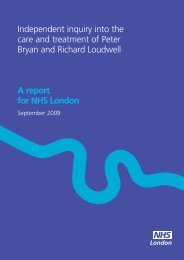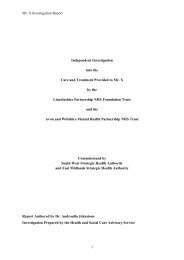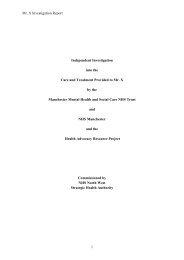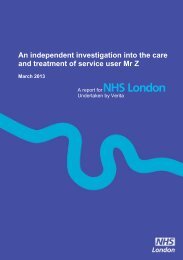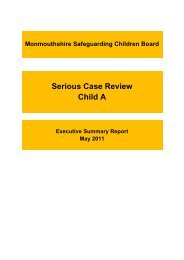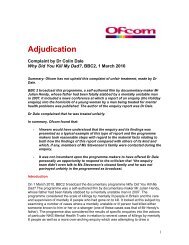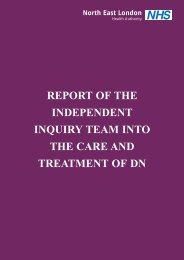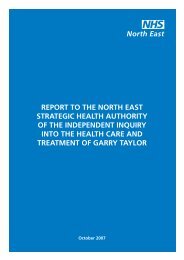Lousia Ovington independent investigation report ... - NHS North East
Lousia Ovington independent investigation report ... - NHS North East
Lousia Ovington independent investigation report ... - NHS North East
You also want an ePaper? Increase the reach of your titles
YUMPU automatically turns print PDFs into web optimized ePapers that Google loves.
CHAPTER 3 – OUTLINE OF MENTAL ILLNESS AND PERSONALITY DISORDER<br />
Chapter 3 – Outline of mental illness and personality disorder<br />
There are three main categories of mental disorder: mental illness, personality<br />
disorders and learning difficulties. The disorders are defined and diagnosed, on the<br />
basis of the existence of specific clusters of symptoms. However, symptoms and<br />
signs of ill health are subjective: experienced, described and interpreted according<br />
to the bias of the patient and / or the clinician. There are very few symptoms that<br />
are pathognomonic of (i.e. relate just to) particular diagnoses: individual symptoms<br />
are common to numerous disorders and thus it is the existence of particular clusters<br />
and numbers of symptoms that is important. In addition, disorders evolve over time<br />
both in terms of their natural history (for example, psychotic symptoms becoming<br />
less pronounced in chronic schizophrenia) and in terms of the understanding of the<br />
individual and their clinician as to what the person is experiencing. It is, therefore,<br />
quite common for a person’s diagnostic “label” to change over time.<br />
Diagnosis informs management. The natures of specific mental disorders are well<br />
known and the risk factors, life histories, likely responses to treatment and prognoses<br />
are therefore reasonably predictable. Mental illnesses, such as post traumatic stress<br />
disorder, bipolar affective disorder and schizophrenia are easier to diagnose than<br />
personality disorders: in lay terms, persons suffering from such conditions are more<br />
clearly “mentally ill” than persons with personality disorders, because personality<br />
characteristics are present in all people, whereas symptoms such as hallucinations and<br />
delusions are not the norm.<br />
An individual’s personality dictates their characteristic lifestyle and mode of relating<br />
to themselves and others. These behaviour patterns tend to be deeply ingrained and<br />
enduring. A person with a personality disorder shows extreme or significant deviations<br />
from the way in which the average individual in a given culture perceives, thinks, feels<br />
and, particularly, relates to others. The behaviour patterns tend to be stable and to<br />
encompass multiple domains of behaviour and psychological functioning. They are<br />
frequently, but not always, associated with various degrees of subjective distress and<br />
problems of social performance. Personality disorders have historically been regarded<br />
as innate and untreatable. They cannot be “cured” by treatment with medication.<br />
It is only over recent years that specific psychological tests have been created to<br />
formalise the diagnosis of the disorders and that effective psychological therapies such<br />
as dialectical behaviour therapy and cognitive behaviour therapy have been developed.<br />
Historically, there was a hierarchy of diagnoses within psychiatric practice. Within this<br />
system, mental illnesses were regarded as more significant and worthy of investment<br />
than personality disorders, in terms of provision of resources for management,<br />
treatment and research. The diagnosis of personality disorder was effectively seen as<br />
a diagnosis of exclusion: patients with such diagnoses were seen as untreatable and<br />
85



